Wednesday, October 30, 2019

CNS photo/Paul Haring
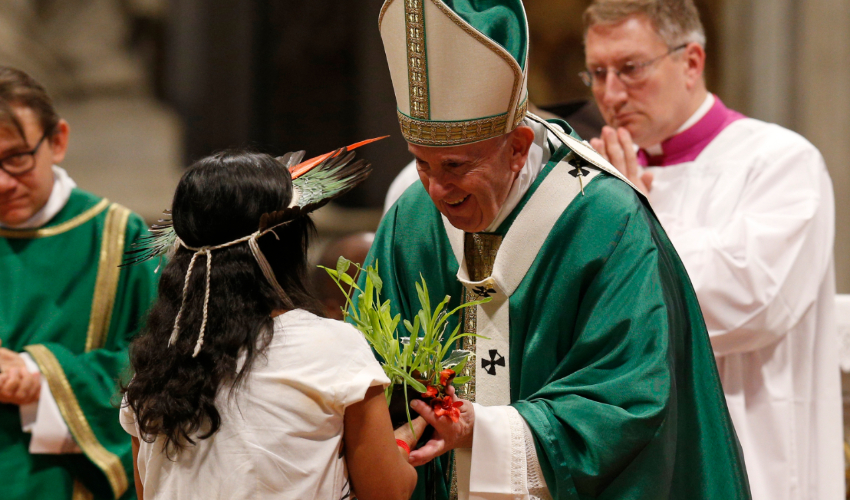
CNS photo/Paul Haring


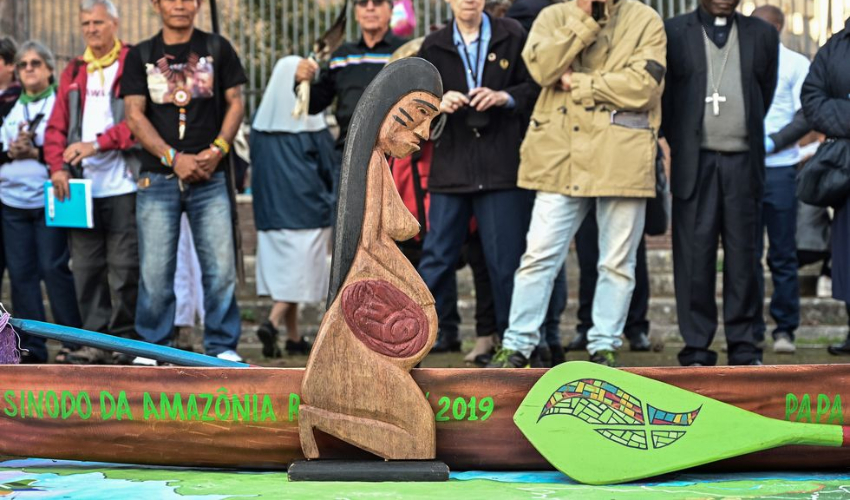
Top, Marcivana Rodrigues Paiva, representing the Satere-Mawe indigenous people in Brazil, carries a plant in the offertory procession as Pope Francis celebrates the concluding Mass of the Synod of Bishops for the Amazon at the Vatican Oct. 27, 2019. (CNS photo/Paul Haring)
Second photo, the same young woman gives the plant to Pope Francis during the offertory of the Mass for the closing of the Amazon Synod in St. Peter’s Basilica on Sunday, Oct. 27, 2019 (AP Photo/Alessandra Tarantino) (link)
Third photo, the same plant on the corner of the altar.
After Francis took the plant from the young woman, he turned and handed it to his Master of Ceremonies, Monsignor Guido Marini. Francis spoke to Marini for a moment. Marini nodded. Marini turned and placed the plant on the corner of the altar. Looking from the nave of the church toward the altar, it was on the far right corner of the altar, just in front of the candles.
The plant remained on the altar during the consecration and to the very end of the Mass, and was still there after all of the celebrants had left the church.
Fourth photo, a close-up of this same bowl and plant. The plant seems clearly not to be one plant, but four or five different plants, with differently shaped leaves, in one container, with two red flowers, one on each side.
This occurred on the morning of Sunday, October 27 in Rome.
Fifth photo, one of the Pachamama images in Rome in October.
Consult the video
A video of the entire October 27 ceremony may be seen on YouTube at this link.
What happened cannot really be understood without looking at this video and seeing it taking place.
The young woman carrying the plant is the first person in the procession entering the church. You can see this at 23 seconds. She is carrying the plant.
The offertory comes 56 minutes into the video.
At 56:30 the young woman brings the plant as an offering to the Pope.
At 56:40, the Pope turns to Guido Marini and speaks to him as he hands the plant to him.
At 56:45, Marini immediately turns and sets the plant on the corner of the altar. It is never moved.
At the very end of the video, at 1:32:38, the camera focuses on the plant and zooms in on it for about 12 seconds, then cuts to the cross above the baldacchino and the program ends.
“During the offertory or immediately before it, a collection of money or other gifts for the poor or for the church is taken up. In the Roman Rite Mass, these may be brought forward together with the bread and wine, but they are not to be placed on the altar.” —Wikipedia, Offertory (link)
“73. At the beginning of the Liturgy of the Eucharist the gifts, which will become Christ’s Body and Blood, are brought to the altar. First, the altar, the Lord’s table, which is the center of the whole Liturgy of the Eucharist, is prepared by placing on it the corporal, purificator, Missal, and chalice (unless the chalice is prepared at the credence table). The offerings are then brought forward. It is praiseworthy for the bread and wine to be presented by the faithful. They are then accepted at an appropriate place by the priest or the deacon and carried to the altar. Even though the faithful no longer bring from their own possessions the bread and wine intended for the liturgy as in the past, nevertheless the rite of carrying up the offerings still retains its force and its spiritual significance. It is well also that money or other gifts for the poor or for the Church, brought by the faithful or collected in the church, should be received. These are to be put in a suitable place but away from the Eucharistic table.” —General Instruction of the Roman Missal, Paragraph 73
“The OFFERTORY of the Liturgy refers to the OFFERING of the Bread and Wine for the Eucharist–which historically is their actual placing on the altar, regardless of what other prayers or ceremonies accompanied this. Since nothing else can be the matter for the Eucharistic Sacrifice, besides bread and wine mingled with water, nothing else can be or should be on the altar. The Holy Oils are placed there since the are the matter of a Sacrament. Wedding rings are blessed on the altar since they are the emblem of a Sacrament. Perhaps tokens of other things, such as gifts for the poor, can be brought up — though not at the same time as the Eucharistic matter — to be blessed, but should NOT be placed on or near the altar, and should be removed immediately after this blessing.” —Catholic Answers Forum (link)
The final Mass
On Sunday after the closing Mass of the Synod on the Amazon, after speaking with a Vatican Press office official to be sure I had not “missed” something, I tweeted out a brief message: the controversial carved wooden Pachamama images, I wrote, were not present at the final Mass of the Amazon Synod.
My “news” was picked up by a handful of people and retweeted; for example, by Gloria TV (link).
So the word was “out” — no Pachamama images at the final Synod Mass.
This non-presence of naked images of a pregnant woman at the final Synod Mass seemed somehow good news, because the images had become quite controversial.
Therefore, it seemed better that they had not been brought in, better that they had not distracted attention from the sacrifice of Jesus Christ, and his mystical presence with us. So I thought.’
The controversy over the images had erupted after many Catholic observers — including some bishops and cardinals (see this link) — had protested that the images were problematic, since (as it seemed) they were pagan religious idols, used in indigenous pagan religious ceremonies, and so had no place in any Catholic place of worship, in or out of the Vatican, or near (or on) any Catholic altar at any time, especially during a sacred liturgy.
But Vatican spokesmen, including the Pope himself, had tended to downplay such concerns, saying the images were not in fact in any way truly “idolatrous,” proposing instead that they were simply traditional cultural artifacts from the Amazon region, from either Brazil or Peru.
“We know that some things in history can have many interpretations, and even in the Church you can find things that come from the [pre-Christian, i.e., pagan?] past, but the statue simply represents life, period, while trying to see symbols of paganism is seeing evil where it’s not there,” insisted Italian Catholic layman Paolo Ruffini, the Vatican’s top communications official.
On Friday, October 25, Pope Francis, announcing to the Synod that the wooden Pachamama images, which had been had been brought to the church of St. Mary in Traspontina “without idolatrous intentions” and then had been tossed into the Tiber River at dawn on October 21 by two outraged Catholics, had been found.
Again, it must be noted that Francis specified that the images had been displayed “without idolatrous intentions.”
So Francis added his authority to that of his spokesmen.
But one does not emphatically deny what has not come into serious question.
And even here there was a certain lack of clarity, for there is a difference between the nature of an image in itself, and the intentions of those who handle or display that image.
The thing in itself, and the intentions with regard to the thing…
That is, something may in itself be idolatrous, but those who handle or display it may (fortunately) not have “idolatrous intentions.”
Yet that does not abrogate the reality that the item is idolatrous.
This grey-ish area of confusion and lack of clarity about these “Pachamama” images — for the Pope himself confirmed that they were indeed “Pachamama” carvings — led to a certain bewilderment and consternation even among some of the bishops present at the Synod.
When the Pope told the 180 or so Synod Bishops on Friday, October 25, that it might be possible that the Pachamama images would be brought into St. Peter’s basilica to be present at the final Mass of the Synod on October 27, he raised several eyebrows (link).
At least a few of the bishops were reportedly overheard — see LifeSiteNews (link), citing the German website Kath.net (link) — saying to one another saying they would not attend the final Synod Mass if the naked images of the pregnant woman were present in the basilica.
Kath.net wrote: “Man hört aus gewöhnlich gut informierten Kreisen des Vatikans, dass es seitens von Bischöfen vorab Aussagen gegeben habe, wonach sie nicht an der Abschlussmesse teilnehmen könnten, wenn diese Figuren benutzt werden würden.” (“One hears in usually well-informed Vatican circles of bishops who have stated in advance that they would not be able to attend the closing Mass if these figures were used.”)
Here once again, for the record, are the Pope’s words on October 25, confirmed by the Vatican Press Office:
Good afternoon, I would like to say a word about the pachamama statues that were removed from the Church at Traspontina, which were there without idolatrous intentions and were thrown into the Tiber.
First of all, this happened in Rome and, as bishop of the diocese, I ask pardon of the people who were offended by this act.
Then, I can inform you that the statues which created so much media clamor were found in the Tiber. The statues are not damaged.
The Commander of the Carabinieri [Italian police] wished to inform us of the retrieval before the news becomes public. At the moment the news is confidential, and the statues are being kept in the office of the Commander of the Italian Carabinieri.
The leadership of the Carabinieri will be very happy to follow any indication given on the method of making the news public, and regarding the other initiatives desired in its regard, for example, the commander said, “the display of the statues at the closing Mass of the Synod.” We’ll see.
I delegate the Secretary of State who will respond to this.
This is good news, thank you.
—Pope Francis
The mystery of the ritual…
So, what happened?
We know that, on Friday, Pope Francis was still entertaining the idea of displaying the Pachamama “statues” at the closing Mass of the Synod.
And we know that, in the end, the Pachamama carvings were not displayed.
We know — or think we know — that some bishops were murmuring that they would boycott the Mass if the Pachamama images were present.
So we know that these bishops felt the Pachamama images were problematic to the point of being idolatrous, images associated in some way with a type of pagan worship which they wished not to associate with.
And we know, as a Vatican Press Office spokesperson told me, that it was decided in the end that the Pachamama images would be “kept in the Synod Hall,” and not brought over into the Basilica to be present at the Mass.
And yet, this final offertory gift, this bowl containing soil and several plants, was not only brought up to Pope Francis, but it was placed on the altar.
Somehow that seemed odd to me.
Is it usual to place an offertory gift on the altar?
I had never seen it before, or so it seemed to me.
What was that bowl, that collection of plants? What did it signify?
Late on Sunday, I started to read about the rituals associated with Pachamama, the spirituality associated with Pachamama images — for the Pope had made clear that these images did represent Pachamama.
Some during the Synod said that Pachamama represents “Mother Earth,” the source of all life, for indigenous Amazon culture.
At first glance, this seems innocent enough.
This earth is where we live, we come from the dust of the earth and return to it.
And we do burn and poison many things in nature, and clearly this is radically reckless, imprudent, arrogant, foolish and, yes, evil, for us to do.
It is not unlike going into someone’s home and tearing up the place.
This is our home.
But is there something more in this “Mother Earth” veneration?
I found that a Spanish-born bishop in Brazil felt that the Pachamama rituals were un-Christian and in some way spiritually dangerous. (link)
“Mother Earth should not be worshipped because everything, even the earth, is under the dominion of Jesus Christ,” said Bishop Emeritus José Luis Azcona Hermoso of the Brazilian city of Marajó in an October 20 homily at the cathedral in the state of Pará. “Pachamama is not and never will be the Virgin Mary. To say that this statue represents the Virgin is a lie. She is not Our Lady of the Amazon because the only Lady of the Amazon is Mary of Nazareth. Let’s not create syncretistic mixtures… The invocation of the statues before which even some religious bowed at the Vatican… is an invocation of a mythical power, of Mother Earth, from which they ask blessings or make gestures of gratitude. These are scandalous demonic sacrileges, especially for the little ones who are not able to discern.”
And he added: “Here in the Amazon region we know the meaning of macumba or condomblè, which are quite prevalent here.”
LifeSiteNews writes: “Widespread in northeastern Brazil, macumba and condomblè are afro-Brazilian cults that involve propitiation of various gods and goddesses, dances, incantations and sacrifices.” (link)
And then I learned that Bishop Athanasius Schneider, whom I have known for several years and who was here in Rome earlier this month — allowing us a chance to greet each other — had on October 26 issued an “Open Letter” calling on all Catholics “to offer acts of reparation, protest and correction for the use of the Pachamama statues” which he called “a new golden calf.” (link)
Schneider writes: “The example of Christ is of the utmost importance for all people who desire ‘the true God and eternal life’; as St. John the Apostle exhorts us: ‘Little children, keep yourselves from idols’ (1 Jn 5:20-21). In our day, this message has special importance, for syncretism and paganism are like poisons entering the veins of the Mystical Body of Christ, the Church. As a successor to the Apostles, entrusted with care for God’s flock, I cannot remain silent in the face of the blatant violation of God’s holy will and the disastrous consequences it will have upon individual souls, the Church as a whole, and indeed the entire human race. It is therefore with great love for the souls of my brothers and sisters that I write this message.”
And he continues: “On October 4, 2019, on the eve of the Amazon Synod, a religious ceremony was held in the Vatican Gardens, in the presence of Pope Francis and of several bishops and cardinals, which was led partly by shamans and in which symbolic objects were used; namely, a wooden sculpture of an unclothed pregnant woman. These representations are known and belong to indigenous rituals of Amazonian tribes, and specifically to the worship of the so-called Mother Earth, the Pachamama. In the following days the wooden naked female figures were also venerated in St. Peter’s Basilica in front of the Tomb of St. Peter.”
And he continues: “The second-century apologist Athenagoras said about the veneration of material elements by pagans: ‘They deify the elements and their several parts, applying different names to them at different times. They say that Kronos is time, and Rhea the earth, and that she becomes pregnant by Kronos, and brings forth, whence she is regarded as the Mother of all. Missing to discover the greatness of God, and not being able to rise on high with their reason (for they have no affinity for the heavenly place), they pine away among the forms of matter, and rooted to the earth, deify the changes of the elements’ (Apol. 22).”
So I recalled again that, as lovely as this world is, and as much as we must be good stewards of it, it is not our eternal home, for we look “for that which is above.”
An offering to Pachamama
Then, after further searching, I learned that a bowl of soil with plants in it is often connected with ceremonial rituals involving Pachamana.
There is one among many websites that describes the ritual (link):
“If it is difficult for you to move to a natural space to offer to Mother Earth, do not worry, you can perform your own ritual at home:
“- Use a bottle or flower pot full of dirt, there you proceed to make a hole, it is recommended to do it with your hands to connect with the energy of the ritual.
“- A kind of well is made, and food and drinks are poured for the enjoyment of the Pachamama.
“- The food option is extensive, one can place anything from fruits to Creole foods and seeds. In the case of drinks, chicha, natural juices, honey, wine, even coca leaves are suggested.
“- Then we proceed to cover it with dirt and flowers.
“Every year more people join in and they learn to leave our daily work and reflect and realize who we are, where we are and have this gesture of recognition and thanks to Mother Earth, which we say is humanity, the earth, the air, the animals, the water, the fire, which is everything that makes our life.”
Also: “You should never miss something red, it is the favorite color of the Pacha!
So it seemed that the bowl of flowers presented at the offertory of the final Synod Mass, and then placed on the altar during the consecration, may have been connected with a ritual of veneration, and thanks, to Mother Earth, known as Pachamana…
So the images were not in the basilica, but perhaps an offering to Pachamana, in a bowl, was…
Several questions
On Monday I prepared an email of questions for Monsignor Guido Marini, the Master of Ceremonies for the Vatican.
I wrote:
Dear Monsignor Marini,
I would like to ask for a clarification, please.
At the closing Mass for the Synod, a small green plant was brought to the Pope for the offertory, by the last person, a lay woman. The Holy Father received the offer and then gave it to you. The Holy Father indicated with a couple of words (as one gathers from the video of the Mass) to bring the plant to the corner of the altar and leave the plant there during the ceremony, during the consecration. You then placed the plant there, at the corner of the altar.
I wanted to ask:
1) Is it a usual thing to place offerings on the altar during Mass? Has it happened in the past, in St. Peter’s or anywhere else? Can you tell when, on what occasions? (Because it seemed unusual to me; I don’t remember other similar occasions.)
2) Can you explain why this plant remained on the altar, but not the other offerings?
3) Did you know beforehand that this plant should be placed on the altar? Was the idea previously agreed upon with the Holy Father?
4) Can you tell what this plant was, what kind of plant, what it represented? A type of fruit or food or …?
5) Can we know what was written on the container of the plant, and if there were other signs, and what those signs mean?
6) Can you tell where this plant and the container are now? Have they been preserved?
And here is the reply I received yesterday:
Dear Sir,
In reference to your e-mail, we wish to inform you that there is no particular information about the plant; we only know that it was planted at the beginning of the Synod and delivered to the offertory to adorn the altar.
Wishing you every good in the Lord, we send cordial greetings.
The Office of Liturgical Celebrations of the Supreme Pontiff
(to be continued)





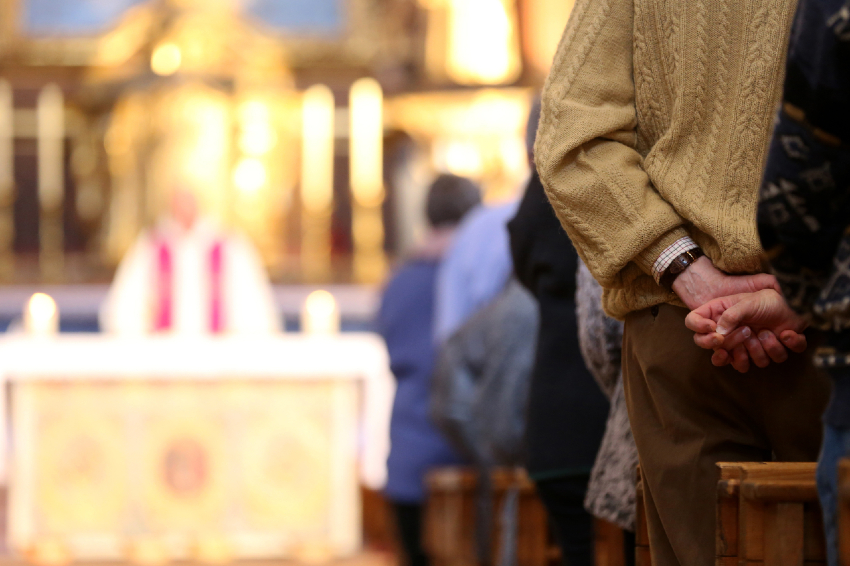
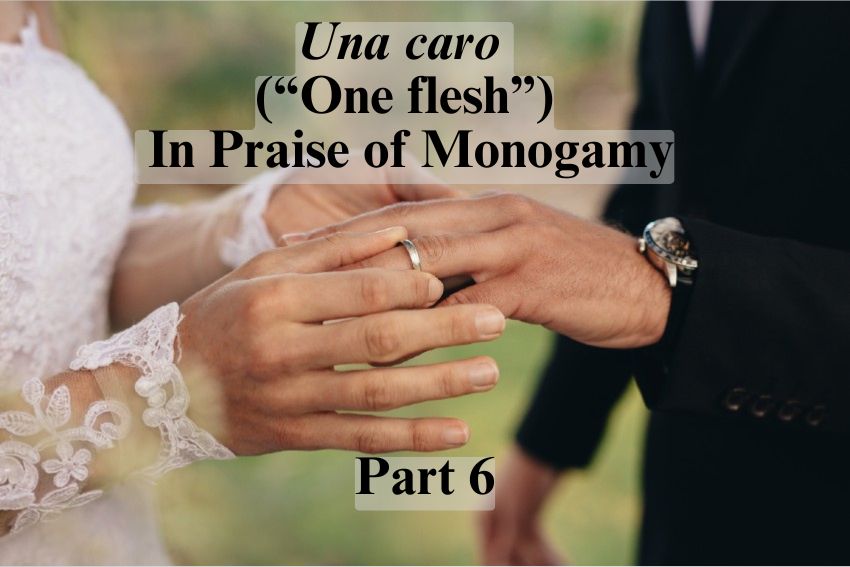

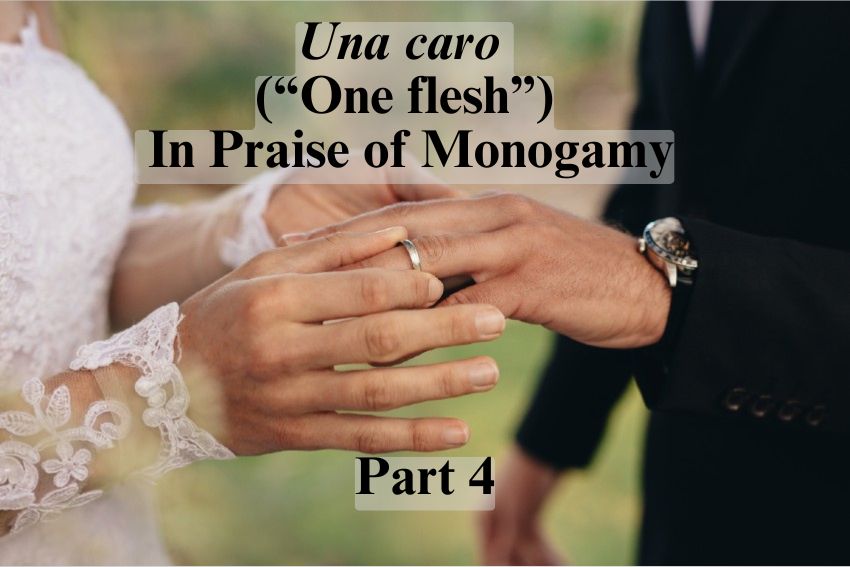
Facebook Comments